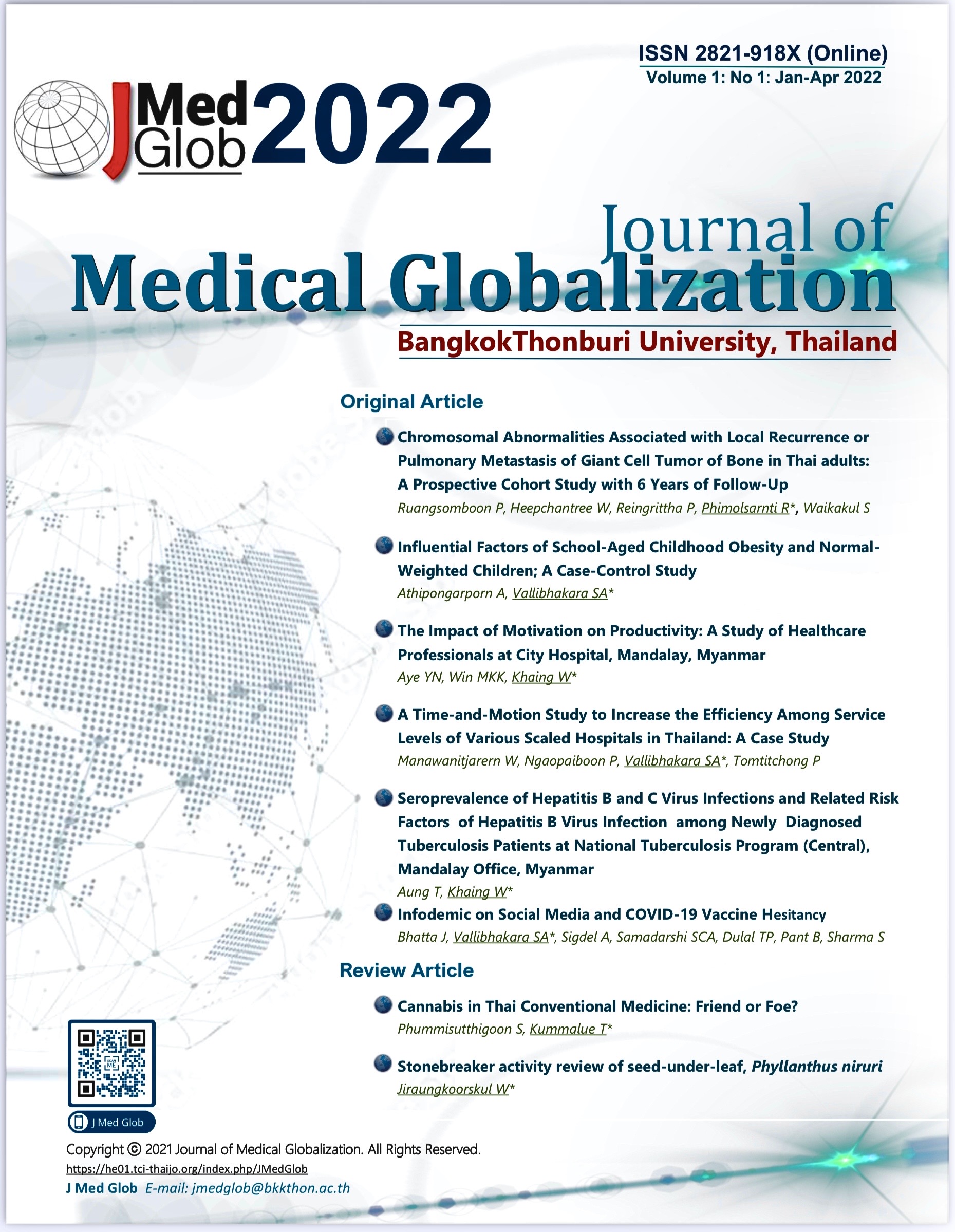Influential Factors of School-Aged Childhood Obesity and Normal-Weighted Children; A Case-Control Study
Keywords:
Childhood obesity, Overweight, Family factor, Physical activity, Diet therapyAbstract
Objective: To find influential factors of obesity in terms of eating behavior, daily activities, and family factors of school-aged childhood obesity compared to healthy and normal-weighted children.
Material and Method: The case-control study of 112 participants (56 from the obesity cases in Childhood obesity Clinic, Phra Nakhon Si Ayutthaya Hospital, compared with 56 control from normal-weighted children from Anuban Phra Nakhon Si Ayutthaya Elementary school, matched age and gender in a ratio of 1: 1. The participants had completed the questionnaire survey. The data was analyzed in the domains of patient factors, nutritional factors, physical activity, and parent-child relationships such as encouragement of eating and preparing and cooking among caregivers.
Results: The obesity ages started from an average of 2.32 years old, with no statistically significant difference between gender (2.16 + 1.1 v.s 2.66 + 1.0 years old, p-value < 0.054), male and female respectively. Domain of nutritional status/diets, the obese children group (case) overall average food intake consumed more than normal-weight children group (control), 3.15+0.19 v.s.2.31+0.14, respectively ( p-value < 0.001). Most obese cases ate more vegetables on average than the normal-weight group, 2.55.+0.19 v.s. 2.08 +0.21, p-value=0.038). The physical activities had at least one active physical exercise; significantly fewer sports were played in the obesity group than in the normal-weight group (2.10+1.08 vs. 2.69+1.00, p-value= 0.003). But, the other physical activities had not shown significance, jogging (2.13+0.75 vs. 2.28+0.8 and swimming (1.28+0.49 vs.1.31+0.46), with p-values of 0.308 and 0.739 respectively. TV watching and time-screen showed statistically significantly higher in the case group than in the control group. The results showed 4.95+2.10 vs. 3.40+1.30 in TV watching (p-value < 0.001), and 4.25+1.08 vs. 3.70+1.43 in time-screen playing (p-value=0.023). Related genetic factors (obesity/metabolic syndrome, Diabetes Mellitus, and abnormal cholesterol in family members), We found only Family DM was statistically more significant in the obese group than in normal-weight children (OR: 2.68,95 % CI 1.09-6.61, p-value = 0.03).
Conclusion: Obesity is significantly present in pre-school and school-age children. We found multifactorial problems are causes, combined with nutrition factors and genetics vulnerable to metabolic disease and encouragement of eating, preparing, and cooking. The key to successfully treating and preventing childhood obesity lies in two main factors: patient and family/or caregivers; coordinate and synchronize among these factors to prevention.
Keywords: Childhood obesity, Overweight, Family factor, Diet therapy, Physical activity
References
World Health Organization. Obesity and overweight fact sheet; 2016 [cited 2022 Jan 9]. Available from: http://www.who.int/mediacentre/factsheets/fs311/en/
Centers for Disease Control and Prevention. Child Obesity Facts; 2017 [cited 2022 Jan 9] Available from: https://www.cdc.gov/healthyschools/obesity/facts.htm
Canoy D, Bundred P. Obesity in children. BMJ Clin Evid. 2011 Apr 4;2011:0325. PMID: 21463538; PMCID: PMC3217765.
Slyper AH. Childhood obesity, adipose tissue distribution, and the pediatric practitioner. Pediatrics. 1998;102(1):e4.
Phulkerd S, Nakraksa P, Mo-Suwan L, Lawrence M. Progress towards Achieving the Recommendations of the Commission on Ending Childhood Obesity: A Comprehensive Review and Analysis of Current Policies, Actions and Implementation Gaps in Thailand. Nutrients. 2021;13(6):1927.
Aekplakorn, W.; Puckcharern, H.; Thaigla, K.; Satheannoppakao, W. Report on the Fifth National Health Examination Survey (2014); Institute, H.S.R., Ed.; Health System Research Institute, Ministry of Public Health and Thai Health Promotion Foundation: Nonthaburi, Thailand, 2016.
Kelly AS, Barlow SE, Rao G, Inge TH, Hayman LL, Steinberger J, Urbina EM, Ewing LJ, Daniels SR; American Heart Association Atherosclerosis, Hypertension, and Obesity in the Young Committee of the Council on Cardiovascular Disease in the Young, Council on Nutrition, Physical Activity and Metabolism, and Council on Clinical Cardiology. Severe obesity in children and adolescents: identification, associated health risks, and treatment approaches: a scientific statement from the American Heart Association. Circulation. 2013;128(15):1689-712.
Sigman-Grant M, Hayes J, VanBrackle A, Fiese B. Family Resiliency: A Neglected Perspective in Addressing Obesity in Young Children. Child Obes. 2015;11(6):664-73.
Börnhorst, C., Wijnhoven, T.M., Kunešová, M. et al. WHO European Childhood Obesity Surveillance Initiative: associations between sleep duration, screen time and food consumption frequencies. BMC Public Health 15, 442 (2015).
Wethington H, Pan L, Sherry B. The association of screen time, television in the bedroom, and obesity among school-aged youth: 2007 National Survey of Children's Health. J Sch Health. 2013;83(8):573-81.
Park SH, Kim MJ, Park CG, McCreary L, Patil C, Norr KF. Family Factors and Body Mass Index Among Korean-American Preschoolers. J Pediatr Nurs. 2015;30(6):e101-11.
Berge JM, Rowley S, Trofholz A, Hanson C, Rueter M, MacLehose RF, Neumark-Sztainer D. Childhood obesity and interpersonal dynamics during family meals. Pediatrics. 2014;134(5):923-32.
Halliday JA, Palma CL, Mellor D, Green J, Renzaho AM. The relationship between family functioning and child and adolescent overweight and obesity: a systematic review. Int J Obes (Lond). 2014;38(4):480-93.
Kelishadi R, Azizi-Soleiman F. Controlling childhood obesity: A systematic review on strategies and challenges. J Res Med Sci. 2014;19(10):993-1008.
Published
How to Cite
Issue
Section
License
Copyright (c) 2022 Journal of Medical Globalization

This work is licensed under a Creative Commons Attribution-NonCommercial 4.0 International License.








